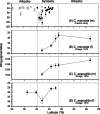Continental variation in wing pigmentation in Calopteryx damselflies is related to the presence of heterospecifics
- PMID: 24949250
- PMCID: PMC4060027
- DOI: 10.7717/peerj.438
Continental variation in wing pigmentation in Calopteryx damselflies is related to the presence of heterospecifics
Abstract
Wing pigmentation in Calopteryx damselflies, caused by the deposition of melanin, is energetically expensive to produce and enhances predation risk. However, patterns of melanisation are used in species identification, greater pigmentation is an accurate signal of male immune function in at least some species, and there may be a role for pigment in thermoregulation. This study tested two potential hypotheses to explain the presence of, and variation in, this pigmentation based on these three potential benefits using 907 male specimens of Calopteryx maculata collected from 49 sites (34 discrete populations) across the geographical range of the species in North America: (i) pigmentation varies with the presence of the closely related species, Calopteryx aequabilis, and (ii) pigment increases at higher latitudes as would be expected if it enhances thermoregulatory capacity. No gradual latitudinal pattern was observed, as might be expected if pigmentation was involved in thermoregulation. However, strong variation was observed between populations that were sympatric or allopatric with C. aequabilis. This variation was characterised by dark wings through allopatry in the south of the range and then a step change to much lighter wings at the southern border of sympatry. Pigmentation then increased further north into the sympatric zone, finally returning to allopatry levels at the northern range margin. These patterns are qualitatively similar to variation in pigmentation in C. aequabilis, meaning that the data are consistent with what would be expected from convergent character displacement. Overall, the results corroborate recent research that has suggested sexual selection as a primary driver behind the evolution of wing pigmentation in this group.
Keywords: Allopatry; Dragonfly; Immune function; Melanin; North America; Odonata; Species recognition; Sympatry; Thermoregulation; Wing.
Figures



Similar articles
-
Thermal response of two sexually dimorphic Calopteryx (Odonata) over an ambient temperature range.Ecol Evol. 2020 Oct 22;10(21):12341-12347. doi: 10.1002/ece3.6864. eCollection 2020 Nov. Ecol Evol. 2020. PMID: 33209292 Free PMC article.
-
Sympatric shift in a male sexual ornament in the damselfly Calopteryx splendens.J Evol Biol. 2011 Jan;24(1):139-45. doi: 10.1111/j.1420-9101.2010.02146.x. Epub 2010 Nov 2. J Evol Biol. 2011. PMID: 21044198
-
Bird predation selects for wing shape and coloration in a damselfly.J Evol Biol. 2015 Apr;28(4):791-9. doi: 10.1111/jeb.12605. Epub 2015 Mar 4. J Evol Biol. 2015. PMID: 25693863
-
Human pigmentation variation: evolution, genetic basis, and implications for public health.Am J Phys Anthropol. 2007;Suppl 45:85-105. doi: 10.1002/ajpa.20727. Am J Phys Anthropol. 2007. PMID: 18046745 Review.
-
Evolution of wing pigmentation in Drosophila: Diversity, physiological regulation, and cis-regulatory evolution.Dev Growth Differ. 2020 Jun;62(5):269-278. doi: 10.1111/dgd.12661. Epub 2020 Apr 4. Dev Growth Differ. 2020. PMID: 32171022 Free PMC article. Review.
Cited by
-
Mixed signals? Morphological and molecular evidence suggest a color polymorphism in some neotropical polythore damselflies.PLoS One. 2015 Apr 29;10(4):e0125074. doi: 10.1371/journal.pone.0125074. eCollection 2015. PLoS One. 2015. PMID: 25923455 Free PMC article.
-
Strong geographical variation in wing aspect ratio of a damselfly, Calopteryx maculata (Odonata: Zygoptera).PeerJ. 2015 Aug 25;3:e1219. doi: 10.7717/peerj.1219. eCollection 2015. PeerJ. 2015. PMID: 26336648 Free PMC article.
-
A red flag: an experimental analysis of the function of pink colouration in males of Calopteryx haemorrhoidalis asturica (Odonata: Calopterygidae).R Soc Open Sci. 2024 Jun 12;11(6):240144. doi: 10.1098/rsos.240144. eCollection 2024 Jun. R Soc Open Sci. 2024. PMID: 39100150 Free PMC article.
-
Latitudinal gradient of thermal safety margin in an Australian damselfly: implications for population vulnerability.R Soc Open Sci. 2025 Mar 5;12(3):241765. doi: 10.1098/rsos.241765. eCollection 2025 Mar. R Soc Open Sci. 2025. PMID: 40046666 Free PMC article.
References
-
- Abbott JC. 2007. OdonataCentral: an online resource for the distribution and identification of Odonata. Available at http://www.odonatacentral.org (accessed 1 April 2010)
-
- Abrams PA. Evolution and the consequences of species introductions and deletions. Ecology. 1996;77:1321–1328. doi: 10.2307/2265529. - DOI
-
- Ardia DR. The ability to mount multiple immune responses simultaneously varies across the range of the tree swallow. Ecography. 2007;30:23–30. doi: 10.1111/j.0906-7590.2007.04939.x. - DOI
-
- Contreras-Garduño J, Canales-Lazcano J, Córdoba-Aguilar A. Wing pigmentation, immune ability, fat reserves and territorial status in males of the rubyspot damselfly, Hetaerina americana. Journal of Ethology. 2006;24:165–173. doi: 10.1007/s10164-005-0177-z. - DOI
LinkOut - more resources
Full Text Sources
Other Literature Sources

